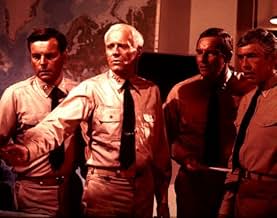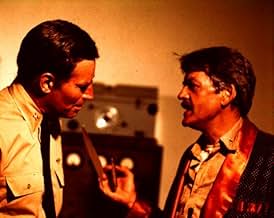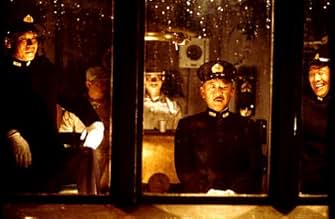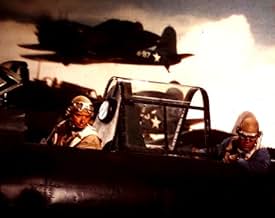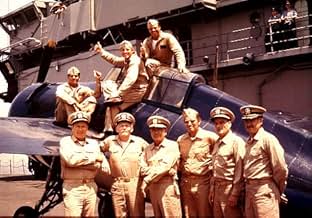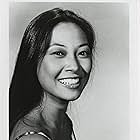A dramatization of the battle that was widely heralded as a turning point of the Pacific Theatre of World War II.A dramatization of the battle that was widely heralded as a turning point of the Pacific Theatre of World War II.A dramatization of the battle that was widely heralded as a turning point of the Pacific Theatre of World War II.
Toshirô Mifune
- Admiral Isoroku Yamamoto
- (as Toshiro Mifune)
- Director
- Writer
- All cast & crew
- Production, box office & more at IMDbPro
Featured reviews
Of course "Midway" is a flawed movie. The subplot about Japanese-Americans is ridiculous and seems like a forced attempt to be PC during the post-Vietnam 1970s when it wasn't in fashion to be completely celebratory of America. Of course it's unsatisfying that the Japanese actors don't speak Japanese and we have to hear Paul Frees dubbing Toshiro Mifune. Of course the stock footage isn't going to please aviation and naval buffs who know these details like the back of their hands, but to me this is a trivial complaint that fails to take into account the limits of 1970s technology or budgeting. "Pearl Harbor" ultimately got those details right through CGI and the end result was a far worse film in the final analysis. Because ultimately, for all the flaws that are in "Midway" it succeeds because it does stick to the essential truths when telling the story of the battle, and I know this because when I first saw this movie on the CBS Late Movie around 1979, I got so hooked that I went out and read every book on the battle I could find including Walter Lord's "Incredible Victory." The movie had given me a starting reference point and while I was sorry that some key aspects of the latter stages of the battle were not depicted (such as the torpedoing and eventual sinking of the Yorktown), I couldn't have asked for anything better in terms of getting me to learn more about this great turning point of World War II. As far as I'm concerned, it's good that Hollywood did tackle this subject in an era when the influence of "Tora! Tora! Tora!", "The Longest Day" etc. still hung over the proceedings because if it hadn't been made back then, we would today be forced to see it given the "Pearl Harbor" and "Titanic" treatment that is pure garbage.
John Williams contributes one of his finer pre-Star Wars scores with two great themes, the "Midway March" (which is only heard in the end credits of the theatrical version and became more popular in an expanded concert arrangement by the Boston Pops) and the "Men Of The Yorktown March" which dominates much of the score and offers great foreshadowings of the Throne Room sequence in "Star Wars" and the Smallville music in "Superman."
John Williams contributes one of his finer pre-Star Wars scores with two great themes, the "Midway March" (which is only heard in the end credits of the theatrical version and became more popular in an expanded concert arrangement by the Boston Pops) and the "Men Of The Yorktown March" which dominates much of the score and offers great foreshadowings of the Throne Room sequence in "Star Wars" and the Smallville music in "Superman."
I first saw this movie when it was opening as a 10 year old boy who was enamored with WWII. At that time to me, it was one of the best war movies I had ever seen. Due to my prior readings on the battle, I knew it followed the history fairly well, and I was able to tune out the romance sub plot. The look of movie was something that was something I was not familiar with in war movies up to that point. The indoor officers were in nice neat uniforms, while the pilots, Marines, and common sailors had a weary rumpled look. And the language! I had not yet heard so much cursing in a war movie (it was 1976 and for the most part John Wayne type movies were the norm). But I loved it all! I knew most of the planes shown on screen were not accurate, and much of the combat footage was from later in the war. But it showed a different type of war movie. The Japanese were strong, smart, and nearly invincible. Not monsters or maniacs, but allowing overconfidence at times to cloud some decisions. The Americans were brave, novices, unsure of themselves at times, yet determined not to fail, no matter the cost. Not the overpowering unbeatable force of years to come later in the war. Watching during the initial phases of combat as obsolete US planes were shot down one by one by the superior Japanese fighters, I was captivated by the self sacrifice(a year later the ending dogfight in Star Wars would make me think of Torpedo 8). Then the tide turned as events, luck, and timing change the course of battle. In the end, the US wins, the Japanese are defeated, and survivors ponder the results and reasons why briefly. Flash forward 32 years later and I watch this movie again on my DVD copy on the 66th anniversary of the battle. This movie holds up not too badly against the test of time. Much time has passed in by movie making and in my gaining knowledge of this subject. To me the strengths still hold, as do the weaknesses. The interracial romance subplot is certainly a 70s addition. Certainly not believable in a historical context. The stock footage of aircraft certainly still glares in error as well. Color footage was shot during the battle and released in a documentary. A small amount was incorporated into the movie. Much more could have replaced other sequences that were used in the movie. Many of the Tora!Tora!Tora! conversion aircraft were still local to Universal Studios at Orange County or Chino airports at the time of filming. Some were used in the Midway Island bombing sequence, but not in the Yorktown attacks. Too bad they did not make more use of them for a better look. The Japanese film sequences from "Storm Over the Pacific" actually worked very well for their capturing the look of the Japanese carriers and the activities on board. As did the lifted opening from "30 seconds Over Tokyo". Much of the dialog on film is true to life with certain quotes historically accurate. "Look at that b*****d burn", was the first radio message clearly heard on the US carriers letting them know any of the air strikes had made contact and been successful. It also holds up sticking fairly close to the time line of actual events, but there are several events omitted. Finally the effects were not bad. For pre CGI the choices are to build full scale mocks ups, use an area or item that has a resemblance or miniatures. All three methods were used to good effect. And the results were for the most part just as good as, if not better than the more modern (film making wise) CGI heavy "Pearl Harbor". All in all, a decent war movie, still worth watching, flaws and all.
As many others have stated, the flaws in this film are many. There is the unnecessary subplot of an American aviator and his interned Japanese/American girlfriend, which serves as nothing more than a gratuitous distraction. Limits in 1976 technology forced the use of cheap-looking special effects and recycled footage from other movies and war footage, often resulting in incorrect historical portrayals of the ships and aircraft present. Some historical plot details were omitted or glossed over entirely, mostly due to production and budget limits. And the acting was uneven, and in a few parts pretty bad, and sometimes failed to realistically portray a few figures.
But there are few war movies that can generate as much excitement in me to this day like this one. I first saw this movie as a two-part NBC Movie of the Week when I was ten years old and instantly developed a passion for the Battle of Midway and WWII military history in general. The climatic scene of the dive bombers pounding the Japanese carriers into wrecks still gives me goosebumps thirty-five years later, as does the horror of watching a young fighter pilot nearly burn to death in his plane. The John Williams score was fantastic, as it was in many movies, and kept the sense of drama on the edge. And for me, the standout performances were by Henry Fonda as Admiral Nimitz, Glenn Ford as Admiral Spruance, and James Shigeta as Admiral Nagumo. Fonda brought to life Nimitz's cool but tough demeanor, and his willingness to take calculated risks based on his intelligence sources, rather than play it safe and guard what he has left. Ford played Spruance well as a calm, cerebral admiral that plays by his own instincts rather than the way the man he replaced (Halsey) would've played it. And I enjoyed Shigeta's portrayal of Nagumo as a leader who, despite his perceived material superiority, is wary of the lack of intelligence and communication regarding the whereabouts of the American fleet, and the uncertainty of what really may be waiting for his carriers as he undertakes his mission.
It's real easy to pick apart the historical details of this movie, especially given more recent information and sources that weren't available back in 1976. But even allowing for that, the movie stays mostly true to history. And to those who aren't looking to nitpick details and just want to enjoy the story being told, there's more than enough "wow" in this movie even almost forty years later. I would recommend it as a primer for young kids (but not too young, there is some blood, language, and tense scenes) with an interest in military and WWII history that hasn't yet researched more comprehensive works written like Walter Lord's Incredible Victory, Gordon Prange's Miracle at Midway, and Anthony Tully/Jonathan Parshall's Shattered Sword.
I would like to see Hollywood do another adaptation of the battle of Midway someday, but am fearful of them turning it turning into another Pearl Harbor, or becoming a political statement rather than the retelling of an incredible true story. Until that day comes, this one will have to do. And it does surprisingly well, if you can tolerate the flaws and just enjoy the show.
But there are few war movies that can generate as much excitement in me to this day like this one. I first saw this movie as a two-part NBC Movie of the Week when I was ten years old and instantly developed a passion for the Battle of Midway and WWII military history in general. The climatic scene of the dive bombers pounding the Japanese carriers into wrecks still gives me goosebumps thirty-five years later, as does the horror of watching a young fighter pilot nearly burn to death in his plane. The John Williams score was fantastic, as it was in many movies, and kept the sense of drama on the edge. And for me, the standout performances were by Henry Fonda as Admiral Nimitz, Glenn Ford as Admiral Spruance, and James Shigeta as Admiral Nagumo. Fonda brought to life Nimitz's cool but tough demeanor, and his willingness to take calculated risks based on his intelligence sources, rather than play it safe and guard what he has left. Ford played Spruance well as a calm, cerebral admiral that plays by his own instincts rather than the way the man he replaced (Halsey) would've played it. And I enjoyed Shigeta's portrayal of Nagumo as a leader who, despite his perceived material superiority, is wary of the lack of intelligence and communication regarding the whereabouts of the American fleet, and the uncertainty of what really may be waiting for his carriers as he undertakes his mission.
It's real easy to pick apart the historical details of this movie, especially given more recent information and sources that weren't available back in 1976. But even allowing for that, the movie stays mostly true to history. And to those who aren't looking to nitpick details and just want to enjoy the story being told, there's more than enough "wow" in this movie even almost forty years later. I would recommend it as a primer for young kids (but not too young, there is some blood, language, and tense scenes) with an interest in military and WWII history that hasn't yet researched more comprehensive works written like Walter Lord's Incredible Victory, Gordon Prange's Miracle at Midway, and Anthony Tully/Jonathan Parshall's Shattered Sword.
I would like to see Hollywood do another adaptation of the battle of Midway someday, but am fearful of them turning it turning into another Pearl Harbor, or becoming a political statement rather than the retelling of an incredible true story. Until that day comes, this one will have to do. And it does surprisingly well, if you can tolerate the flaws and just enjoy the show.
Again I am forced to say this. History is impossible to film as it happened. Everything is based on someone's memory and rarely on the facts, whatever they happen to be. With the possible exception of Charlton Heston being over cast for what should have been a lessor role with a lessor actor, this film has nothing...I repeat nothing to be ashamed about. The viewing of the events leading up to Midway, just as in the equally watchable "Tora! Tora! Tora!" is helped by being viewed from both sides. It makes it easier, for one thing to understand the motivations of both sides.
I am always entrusted in the music, and the music here was excellent as always. Very fitting to the film. I have to say I am not one for war movies usually, so it takes something special to interest a history major like myself.
I am always entrusted in the music, and the music here was excellent as always. Very fitting to the film. I have to say I am not one for war movies usually, so it takes something special to interest a history major like myself.
I remember reading that this movie was made primarily because they had excessive footage from when they shot "Tora! Tora! Tora! and some of the shot looks like they did came from that film. But this film also includes old actual shots taken by service men and news people.
The movie is based on the American victory off Midway Island. The movie was made 30 years after WWII and a couple of years after Vietnam, so it doesn't have a jingoistic feel to it. It has more of a matter of fact feel to it, more a docudrama than propaganda.
The movie is different from most war movies because it shows how Grand battles are won and lost. There isn't much individual heroism from ordinary soldiers shown. Instead we see how commanders, in this case admirals make decisions and take risks usually based on sketchy information. They put their reputations on line, along with the safety of their men, and the security of their nations. We see how the outcome of a battle can hinged on risky decisions or sometimes on indecision. We see how commanders have to sweat out their decisions as History hangs on the balance. Yes! History! This battle after all is considered the turning point of the War in the Pacific.
In this movie decisions are made on what certain letters mean, whether enemy carriers are where they are supposed to be. If viewers give it the appropriate attention, they will see that this movie plays like a giant chess match. The outcome determined by gutsy moves and bad decisions, sometimes indecision.
The movie boasts an impressive cast which include, Henry Fonda, Glenn Ford, Robert Mitchum, Cliff Robertson, Charlton Heston and they all do fine jobs. They play the typical Grand characters in epic movies, they move the story along but has no personal stories themselves. The one personal story belongs to Edward Albert, who plays Heston's son. He's not very convincing and playing opposite a pro like Mr. Heston, he comes across as being weak almost amateurish.
The movie is good but far from great. I love how the filmmakers remained true to the events. But the special effects looked cheap and the use of actual combat footage feels inappropriate and even exploitive. Nevertheless I think it's a good film not to be missed by Military History buffs.
The movie is based on the American victory off Midway Island. The movie was made 30 years after WWII and a couple of years after Vietnam, so it doesn't have a jingoistic feel to it. It has more of a matter of fact feel to it, more a docudrama than propaganda.
The movie is different from most war movies because it shows how Grand battles are won and lost. There isn't much individual heroism from ordinary soldiers shown. Instead we see how commanders, in this case admirals make decisions and take risks usually based on sketchy information. They put their reputations on line, along with the safety of their men, and the security of their nations. We see how the outcome of a battle can hinged on risky decisions or sometimes on indecision. We see how commanders have to sweat out their decisions as History hangs on the balance. Yes! History! This battle after all is considered the turning point of the War in the Pacific.
In this movie decisions are made on what certain letters mean, whether enemy carriers are where they are supposed to be. If viewers give it the appropriate attention, they will see that this movie plays like a giant chess match. The outcome determined by gutsy moves and bad decisions, sometimes indecision.
The movie boasts an impressive cast which include, Henry Fonda, Glenn Ford, Robert Mitchum, Cliff Robertson, Charlton Heston and they all do fine jobs. They play the typical Grand characters in epic movies, they move the story along but has no personal stories themselves. The one personal story belongs to Edward Albert, who plays Heston's son. He's not very convincing and playing opposite a pro like Mr. Heston, he comes across as being weak almost amateurish.
The movie is good but far from great. I love how the filmmakers remained true to the events. But the special effects looked cheap and the use of actual combat footage feels inappropriate and even exploitive. Nevertheless I think it's a good film not to be missed by Military History buffs.
Storyline
Did you know
- TriviaKevin Dobson's character Ensign George Gay, was the sole survivor of Torpedo Squadron 8. Gay wrote a book about his experiences (Sole Survivor) and was an advisor on this film.
- GoofsWhen the cockpit of one of the planes catches fire, the pilot pulls out a fire extinguisher. It is a more modern one, not a fire extinguisher that would have existed in the 1940s.
- Quotes
Vice Adm. Chuichi Nagumo: [commenting on the American torpedo bombers] They sacrifice themselves like samurai, these Americans.
- Alternate versionsA television version exists, with additional cast and plot. It runs four hours with commercials. The main plot points are a Charlton Heston-Susan Sullivan romance and the Coral Sea battle (reffered to in the other version) is played out like the Midway battle. The Coral Sea battle heavily features Mitchell Ryan as Admiral Aubrey Fitch and also includes a subplot where a young Japanese pilot who'd met with Admiral Nagumo to express his opposition to Japanese military action is shot down. At the end of the TV version, Sullivan and Christine Kukobo are both shown waiting dockside.
- ConnectionsEdited from Salute to the Marines (1943)
- SoundtracksIn the Mood
Music by Joe Garland
Performed by the Glenn Miller and His Orchestra (as Glenn Miller Orchestra) on the jukebox at the bar in Hawaii
- How long is Midway?Powered by Alexa
Details
Box office
- Gross US & Canada
- $43,220,000
- Opening weekend US & Canada
- $4,356,666
- Jun 20, 1976
- Runtime2 hours 12 minutes
- Color
- Aspect ratio
- 2.39 : 1
Contribute to this page
Suggest an edit or add missing content



